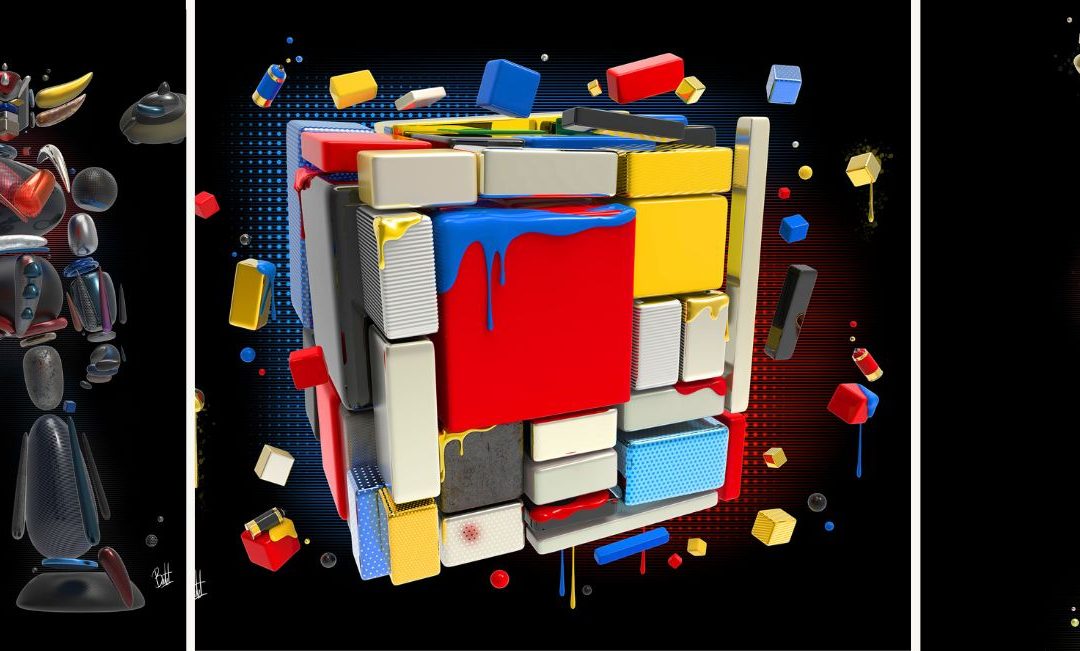
Mar 9, 2018
Boutet, the digital sculptor
Settled in nature, Boutet completed studies in communication and graphic arts at School de Ste-Foy. “You have to have the technique to get rid of it and leave room for creativity,” he says. Raised at dawn, he studied for years with the greatest masters of digital.
Whether they are in Europe, Asia or the United States, his teachers teach him and coach him through the modern tools Facetime and Skype. His continuous development is also based on many courses offered exclusively online.
For 25 years, he has created, invented, animated characters for television and the Web, books and magazines for major international companies such as Universal Music (Universal Music), Hallmark (Hallmark), Colgate (Colgate), Scholastic (Scholastic), the Canadian Olympic Committee (COC), the Museums of Civilization (MCQ), etc. His characters become figurines, doggies, jewels. Its logos give a solid image to the companies that entrust it with the challenge of identifying them well.
Boutet has always been impressed and inspired by Picasso and Miro, by traditional masters and modern eclectic artists. “If Picasso had possessed these modern 3d creative tools, imagine what he would have created! ”
Boutet masters the art of illustration, 3D drawing, video animation and painting. Today, he applies all his experience as a digital art creator in a very unique and personal style.
Boutet’s works are avant-garde while being classical subjects. The impressive grace of his characters is his vision, his design, his choice of materials and their layout, all amalgamated in a light space that he composes of any room.
With such a vision, its experience and all these learnings, not surprising that Boutet creates a new form of art, digital sculpture!
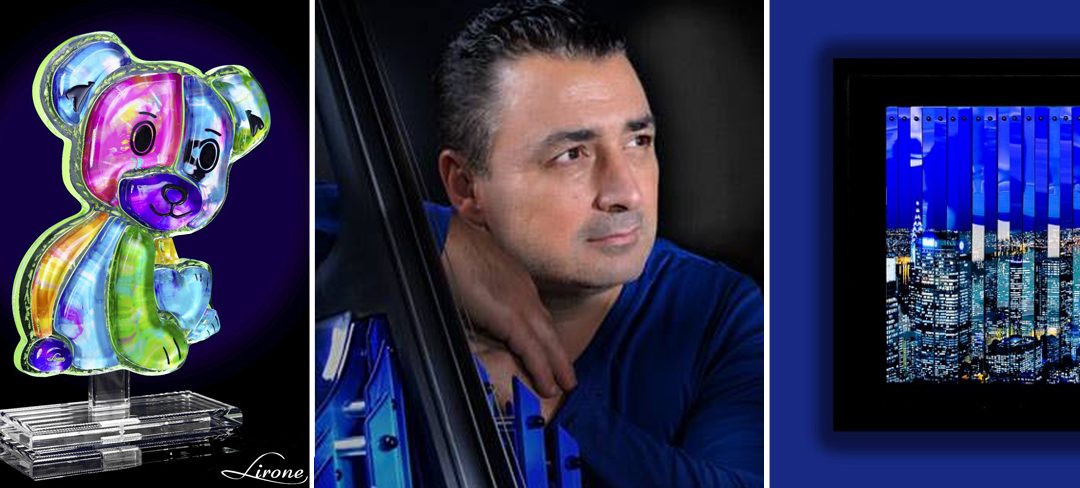
Jan 15, 2018
Lirone is a French plastic photographer born in 1964. As a teenager, he is interested in photography and discover a real passion for this art.
Since 1990, he practices photography as a professional and guided by his passion for the image he is constantly in search of innovative photography techniques.
In 1994, he began his career by specializing in portraiture with a … particular attraction for portraits of babies and children. At the end of the 90s, he expanded his know-how to the world of industrial photography in France and then in the rest of the world (USA, Great Britain, Switzerland …).
He then tackles the automotive industry, fashion, culinary arts, jewelery …
In 2006, he is the creator of a totally innovative concept that combines aesthetics and original photography, painting and sculpture.
This concept is based on a method of direct visualization of a 3-dimensional image. This process is the subject of a patent registered at the INPI for international coverage since August 2006.
“I propose a renewal of the exercise that is to see.Adjust your position: they are constantly redrawing under your eyes.
Move: the pattern breaks down, but keeps. Come back to the work. The look finds the incredible depths of the crystal … “
Lirone is a French plastic photographer born in 1964. As a teenager, he is interested in photography and discover a real passion for this art.
Since 1990, he practices photography as a professional and guided by his passion for the image he is constantly in search of innovative photography techniques.
In 1994, he began his career by specializing in portraiture with a … particular attraction for portraits of babies and children. At the end of the 90s, he expanded his know-how to the world of industrial photography in France and then in the rest of the world (USA, Great Britain, Switzerland …).
He then tackles the automotive industry, fashion, culinary arts, jewelery …
In 2006, he is the creator of a totally innovative concept that combines aesthetics and original photography, painting and sculpture.
This concept is based on a method of direct visualization of a 3-dimensional image. This process is the subject of a patent registered at the INPI for international coverage since August 2006.
“I propose a renewal of the exercise that is to see.Adjust your position: they are constantly redrawing under your eyes.
Move: the pattern breaks down, but keeps. Come back to the work. The look finds the incredible depths of the crystal … “
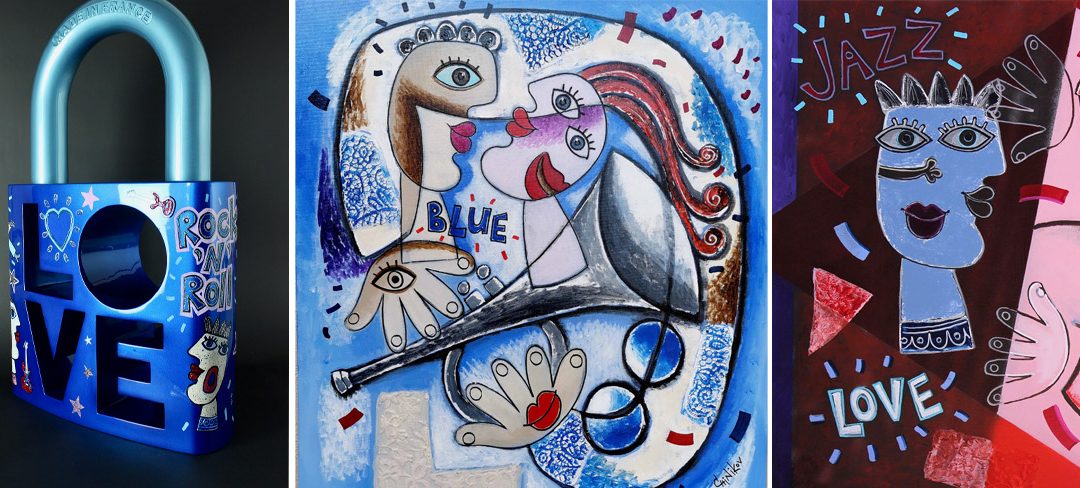
Jan 14, 2017
Stephan Chinikov
Born in 1969, Stephan Chinikov grew up in the city of Sofia, where he showed off his talent for painting at a very early age. He studied at the College of Fine Arts in Sofia between 1984 and 1988 and graduated from the National Academy of Fine Arts in 1994. He quickly realized that the academic style is not what his heart desires and he distinguishes himself by plunging into much freer and expressive universe. In his creations, Chinikov follows the rich traditions of European art while developing a personal touch that is easily recognizable with its distinctive shapes and bright colours. His works are the expression of a true Slavic sensuality, determined by the origins of the artist, whose predominant themes are the eternal love and happiness. “Love is the fibre of life,” says Chinikov, whose Slavic soul is fuelled by true emotions and strong feelings that he expresses and translates into his work. His sources of inspiration are The Life, The Woman and The Music.
With a real freedom of his expression and unlimited imagination, the artist constantly plays with the faces and the bodies in order to destruct the usual forms and to recreate them in an unprecedented way by his imaginary and unique universe. He enjoys constructing his paintings from spots of colour, collages and abstract forms, letting himself to be driven by the improvisation and the spontaneity of the moment. The artist himself describes his works as an intermingling of emotions and colours. This melange is often reinforced by words or phrases that take the spectator in the desired direction. Filled with boundless positive energy, the paintings and sculptures of Chinikov impress with their delicate light, captivate with their vivid colours and overwhelm with their inspiring enthusiasm. Chinikov has more than 30 individual exhibitions and numerous participations in exhibitions in Europe, North America and Asia. His works are present in prestigious private collections of art lovers from all over the world.
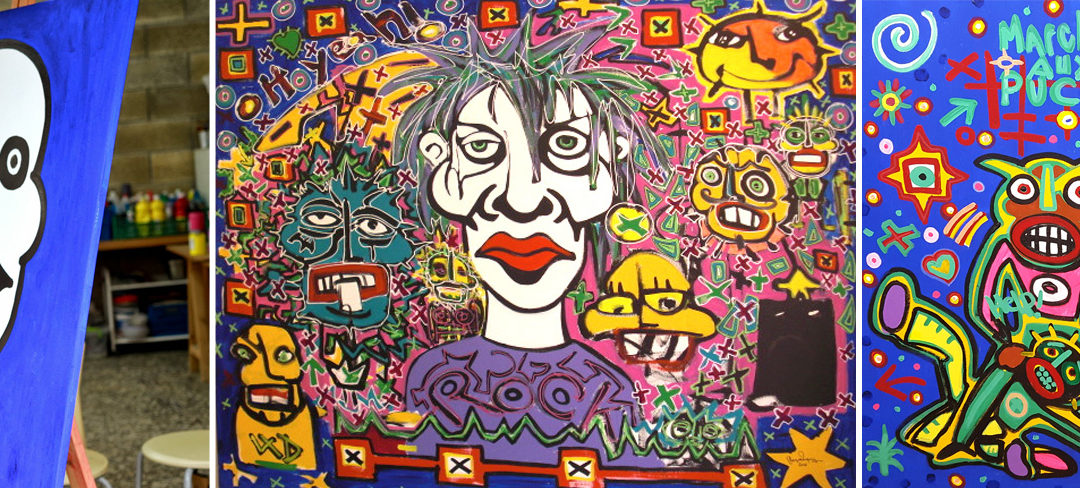
Jan 8, 2017
GEORGES MOQUAY
“The Pigments of Life”
Born in France in 1970, Georges Moquay is a French painter. He is the son of Daniel Moquay and his wife Rotraut Klein-Moquay, widow, since 1962, of Yves Klein.
Course
Until 1982, Georges Moquay lives with his family between France and Spain (Ibiza). Before leaving with his family for Arizona (United States). After his national service in 1991 as an interpreter in the French Navy aboard L’Orage, he returned to Arizona to study photography and the history of art at the University. Since 1995, he has exhibited in many places and galleries in Arizona, France, Spain, Australia …
He lives and works in Paris, multiplying the artistic and visual experiences around the painting, the music, the. Video He shot in the film of Richard Bohringer “It is beautiful a city at night”.
Born in a family where art in all its forms is the master word, a painter of color and expressive explosions, influenced by pop, rock, reggae music, by the signs of modern graphic: tags, grafs, comics …; The references to ethnic communities, Georges Moquay is an artist, fully one can situate in the line of Jean-Michel Basquiat, Robert Combas, etc …
In a paved courtyard of the XIth arrondissement of Paris, a door with two leaves opens on the workshop of Georges. Hangar converted into loft, with original brick floor and high perched frame: a magnificent volume on the scale of its large sizes.
From the start, the tone is given with his character, “the wigger” (a contraction of white nigger) that repeats itself on the walls. One is at the African time and Georges, little white, makes drawings of colors. “The wigger is my Buddha, my Easter Island, my totem,” he declares before explaining that he came this way, at a stroke, thinking of the candy dispenser whose head Rose to let out a small rectangle pastel and sweet. Ah! Childhood !
Then Georges reflected. He told himself that his character as a black man with a white face had to do with the celebrations of the death where Mexican and African are grime in white to make heads of skeletons. And as “nothing is more alive than being close to death,” he then noticed that the luscious lips of his “wigger” resembled the body of a woman lying on a sofa.
In the bric-a-brac of the workshop, where the smell of coffee mingles with that of the essence of turpentine, behind the pots of pigments which he calls his spices, there are rolled canvases. They are immense, painted all-over, with faces-masks, teeth, crosses, hearts, superimpositions of burlesque characters. They are teeming with life and color. From the hip hop culture, from rap, from M.T.V, they have a dadaist side version B.D, pop art on a background of graffiti. “I want my paintings to make me want to dance”. Monaco was not mistaken, choosing as a cover for his invitation card for the Bal de la Rose 2006 (for the benefit of the Princess Grace Foundation of Monaco) a painting by Georges.
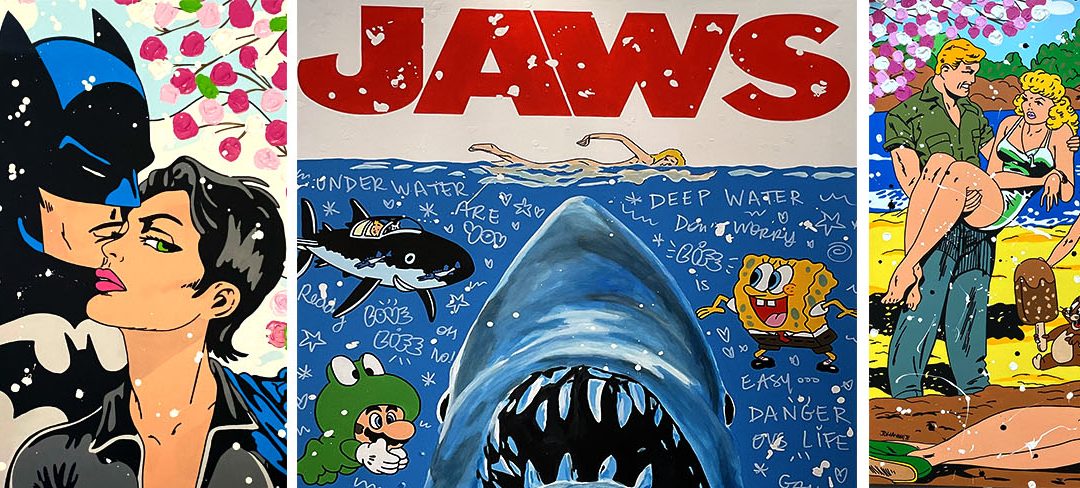
Nov 15, 2016
Johanne 8 ; A name that resonates like a lucky charm when one knows the symbolic meaning of the number attached to the first name of this young artist from Lyons. After a career in aeronautics, she decided to return to her passion for everyday life.
Artist inspired by Liberty, Johanne 8 speaks about society, violence, sexuality, the suffering of people, their little happiness, their smallness in a style inspired by comics, mangas, graff and Pop-Art.
In his paintings, there are many references to the memories of his childhood, to the characters who accompanied him like the superheroes, the American pulps and comics of the 50s, Hello Kitty, Walt Disney but also many winks to US, logos, pubs and all its inspirations from the street …
Johanne 8 was born in Lyon in 1974. She lives and works today in Paris.
It is the curiosity of the world and cultures that takes JOHHANNE 8 on the paths of art. Everywhere she paints, writes and sticks from her earliest age. These many journeys she makes will impregnate in her mind the strong images that are found today in these paintings.
It is especially during a passage in New York that JOHANNE 8 discovers Basquiat. It is an emotional and artistic shock for her, which will now plunge into North American urban culture.
This is how the artist defines himself today as an heiress of Bad Painting, a movement of American graffiti artists. She joined the young artistic movement of “Street Pop” which she shared with other artists like Benjamin Spark, young and talented Belgian artist.
When Johanne 8 returns to settle in Paris, it is to dedicate herself fully to her first love: she writes scenarios for cinema and television. At the same time, she took over the brushes and exhibited paintings where the diversity of the techniques used goes hand in hand with the plurality and the proliferation of visual codes.
Johanne 8 conjugates images, mingled with words, in order to transcribe its inner bubbling and the variety of its artistic and cultural references. It allows the viewer to wonder about his own cultural mosaic, about what constitutes today our mixed identities.
Discovered by a first Parisian gallery in the Marais district, the artist now exhibits his paintings in France and abroad.
The ready-to-wear brand Paul & Joe even asked her to design a basketball model for their Men’s Autumn / Winter 2009/2010 collection ….
Page 6 of 11« First«...45678...»Last »







